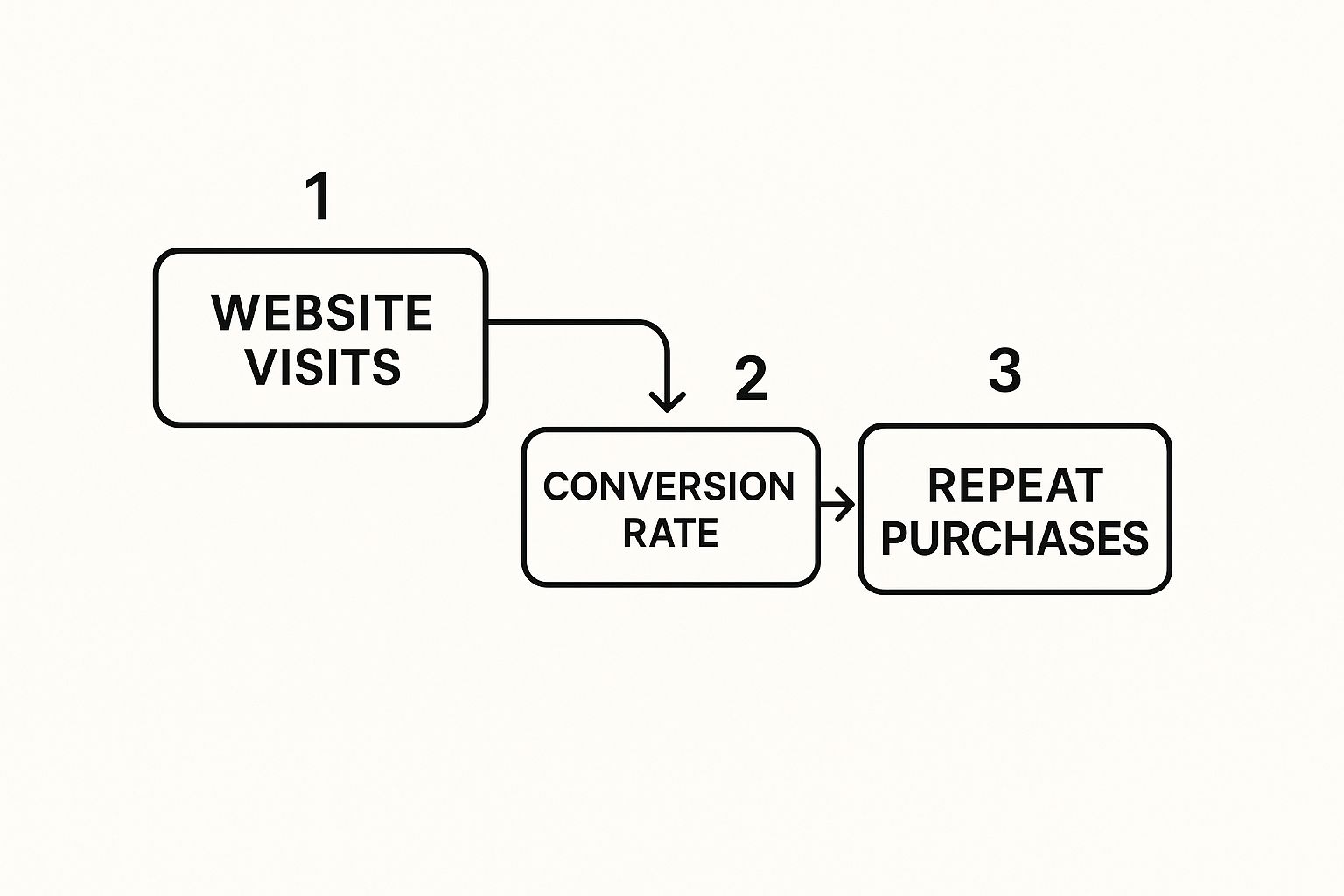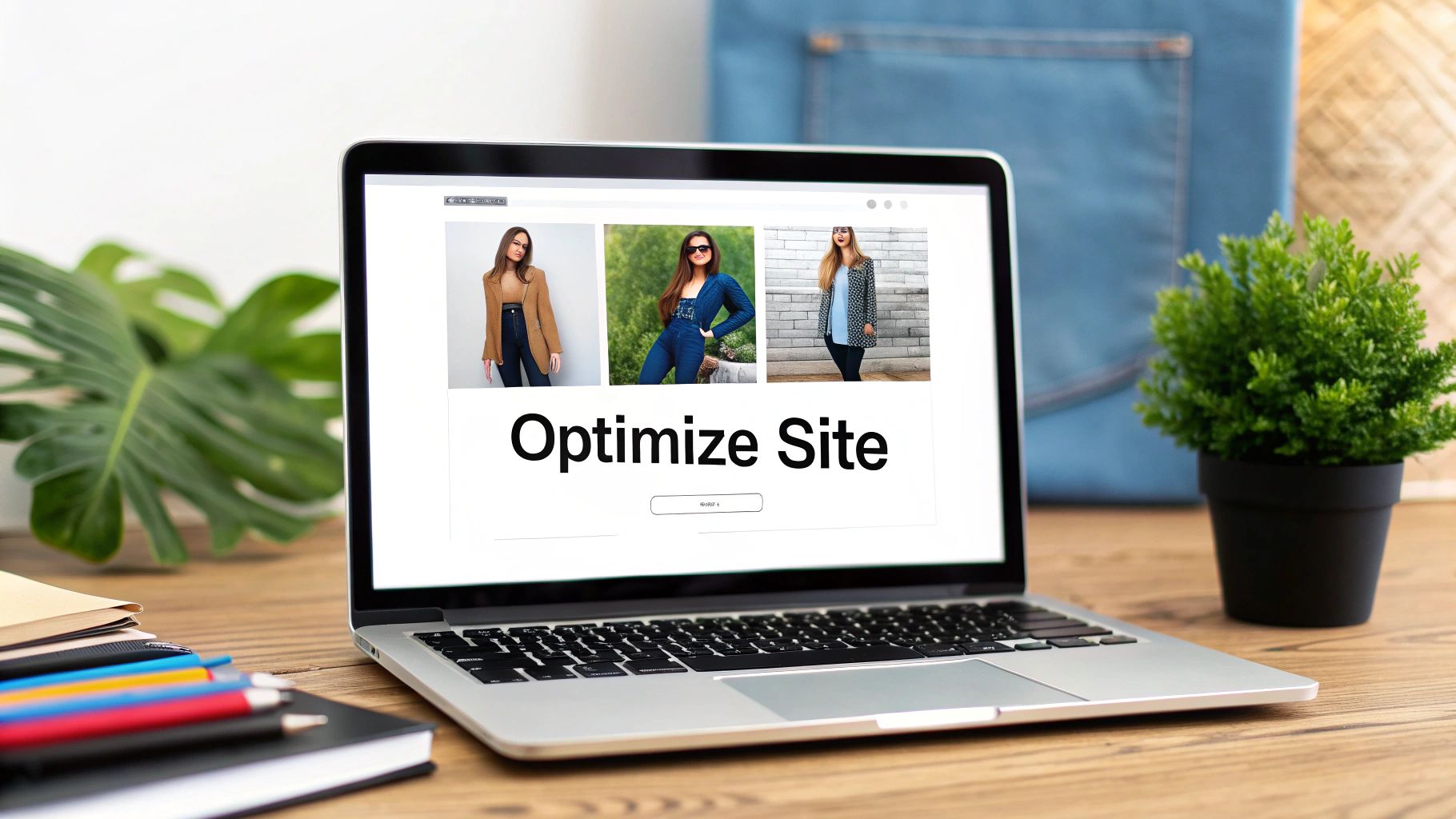If you want to increase online sales, you have to get a few fundamentals right. It all boils down to creating a frictionless customer journey, building a sales funnel that genuinely nurtures relationships, and using data to make smarter decisions. When you dial in these three areas, you build a powerful, repeatable engine for growth.
Think of this as your high-level roadmap for boosting revenue.
Your Blueprint For Boosting Online Sales
Let's cut right to what actually works. Boosting online sales isn't about chasing a single magic bullet. It's about a relentless, strategic focus on the things that matter most.
From my experience helping online businesses scale, the ones that truly succeed are those that never stop optimizing these core areas. They understand that a seamless website, a relationship-focused sales process, and smart data analysis aren't just separate tasks—they're all interconnected parts of a growth machine.
Understanding The Core Pillars
To build a solid blueprint, you need to understand the proven e-commerce growth strategies and how they all click together. This isn't just theory; it's the foundation for every online store that's thriving today.
The numbers don't lie. The global e-commerce market is expected to reach a staggering $6.88 trillion by 2025, with an estimated 28 million online businesses all competing for a slice of the pie. That sheer scale tells you one thing: winging it is not an option. You need a plan.
The visual below breaks down how these pillars work together to drive real revenue.
As you can see, growth is a flywheel. Attracting visitors is just the beginning. The real magic happens when you convert them into customers and then keep them coming back for more. This entire process relies on a powerful combination of top-notch website design and digital marketing to keep the momentum going.
The most effective sales strategies are holistic. You can't fix a leaky bucket by just pouring more water in; you have to patch the holes first. Optimizing your website and sales funnel before you scale traffic is the secret to profitable growth.
To help you get started, this table breaks down the core pillars into clear actions and the results you can expect. This is your starting point for prioritizing what to tackle first.
Core Pillars for Increasing Online Sales
| Growth Pillar | Key Action | Expected Impact on Sales |
|---|---|---|
| Frictionless Customer Journey | Simplify the checkout process and improve mobile speed. | Increased conversion rates and reduced cart abandonment. |
| Nurturing Sales Funnel | Implement targeted email follow-ups and content marketing. | Higher customer lifetime value (CLV) and improved lead-to-customer ratio. |
| Data-Driven Decisions | Analyze user behavior to identify and fix drop-off points. | Higher average order value (AOV) and improved marketing ROI. |
Focusing on these three areas provides a clear, actionable framework. By tackling the key actions for each pillar, you're not just making small tweaks—you're building a more resilient and profitable online business from the ground up.
Turn Your Website Into a Conversion Machine
Think of your website as more than just a digital brochure. It’s your always-on salesperson, your virtual storefront, and the core engine driving your online revenue. To really boost those sales, you have to shift your mindset from "does it look good?" to "does it sell effectively?" This means focusing on the small, critical details that remove friction and build a potential customer's confidence.
The path from a curious visitor to a paying customer should feel seamless and intuitive. Every single click, page, and form field presents a choice: you can either guide them smoothly toward a purchase or frustrate them until they leave.
Simplify The Path to Purchase
I’ve seen it time and time again: the biggest hole in any sales funnel is a clunky, complicated checkout process. It’s a huge problem. In fact, studies consistently show that roughly 70% of all online shopping carts are abandoned. A confusing or long checkout is one of the top reasons people just give up.
Your mission is to tear down every unnecessary barrier standing between a customer adding an item to their cart and finalizing that order.
- Guest Checkout is a Must: Forcing people to create an account before they can give you their money is a classic conversion killer. Let them buy as a guest. It’s that simple.
- Lean into One-Click Payments: Integrating services like Shop Pay, Apple Pay, and Google Pay makes a massive difference. They autofill a shopper's info, turning a tedious form into a single, satisfying click. Checkout-to-order rates on Shop Pay, for example, are 1.72 times higher than a standard checkout.
- Be Ruthless with Form Fields: Do you really need their middle name or a second address line? Probably not. Only ask for what is absolutely essential to process the order. Every extra box is another chance for them to quit.
Making that final step ridiculously easy is how you recover a huge chunk of sales you'd otherwise lose. Of course, all of this is built on having a solid website foundation. If you're building from the ground up, learning how to build a website with these principles baked in from day one is a game-changer.
A seamless checkout experience isn’t a luxury; it's a fundamental requirement. The less a customer has to think, the more likely they are to buy.
Build Trust and Overcome Hesitation
To a first-time visitor, your website is a complete unknown. You have to earn their trust—and their business—in a matter of seconds by addressing their unspoken fears and anxieties head-on. This is where trust signals and social proof become your most valuable assets.
Showcasing what real people think about your products is incredibly persuasive. A staggering 93% of consumers say they read online reviews before making a purchase. You should strategically place these testimonials and reviews throughout your site, especially on product pages and right on the checkout page itself.
Beyond reviews, a few clear trust signals can give hesitant shoppers the nudge they need:
- Money-Back Guarantees: A strong, easy-to-understand return policy completely removes the financial risk for the buyer.
- Secure Payment Logos: Seeing familiar logos like Visa, Mastercard, and PayPal instantly tells a customer that their financial data is safe with you.
- Professional Accreditations: Got a good rating from the Better Business Bureau or another industry-specific certification? Show it off!
When you combine a frictionless checkout with powerful, visible trust signals, you create an environment where visitors feel comfortable and confident enough to pull out their wallets. If you want to dig even deeper, check out these 15 Actionable Shopify Conversion Rate Optimization Strategies for more specific tactics you can implement.
Design a Sales Funnel That Actually Sells
Getting traffic to your site is just the first hurdle. The real challenge—and where the money is made—is turning those visitors into paying customers. This requires a carefully designed journey, a sales funnel, that guides people from their first interaction with your brand all the way to clicking "buy." It's less about a hard sell and more about building trust one step at a time.
A great funnel understands where a customer is mentally. You can't hit someone who just discovered your brand with a sales pitch. It's like asking for marriage on a first date. They need information and value first, something that helps them without asking for their credit card.
Attract the Right People by Being Genuinely Helpful
The top of your funnel is all about casting a wide, yet targeted, net. You do this by offering solutions to problems your ideal customers are actively trying to solve. Don't lead with your product; lead with your expertise.
This is your opportunity to become the go-to resource in your field. Think about what keeps your audience up at night and create content that addresses it.
- Real-World Example: If you sell premium coffee beans, you could write a popular blog post on "The 5 Biggest Mistakes People Make When Brewing French Press Coffee." This pulls in coffee lovers who are serious about their brew.
- Another Idea: A SaaS company offering accounting software could create a free, downloadable "Small Business Quarterly Tax Checklist." It's immensely practical and builds immediate goodwill.
This strategy establishes your brand as a helpful expert, creating a positive first impression long before you ever ask for a sale.
Your goal at the top of the funnel isn't to sell—it's to serve. When you give away your knowledge generously, you earn the permission to take the conversation to the next level.
From Interest to Intent: Nurturing Your Leads
Once you have their attention, the real work begins. Now you need to nurture that initial spark of interest. This is the middle of the funnel, where you build a deeper connection and start showing them why your specific solution is the one they've been looking for. The best tools for this are usually targeted email campaigns and smart retargeting ads.
Let's go back to that accounting checklist. A few days after someone downloads it, you could send them a gentle email with a case study detailing how a similar small business saved hours on bookkeeping with your software. You could also show them a subtle ad on LinkedIn that highlights a time-saving feature. The approach is to be consistently helpful, not annoyingly persistent.
Closing the Deal by Removing All Doubt
The final stage is all about converting that interest into a purchase. By this point, the prospect knows you and trusts you, but they might still be on the fence. This is where you bring out your most powerful asset: social proof.
With over 2.77 billion online shoppers globally, the digital marketplace is crowded and noisy. Trust is the ultimate currency. In fact, a staggering 99% of customers read reviews before buying something. You can dive deeper into these kinds of e-commerce behaviors in this insightful statistical report.
To get them over the finish line, you need to surround the "buy" button with confidence-builders:
- Video Testimonials: Nothing beats seeing a real customer rave about your product. Short, authentic clips are incredibly persuasive.
- Iron-Clad Guarantees: A clear, no-questions-asked money-back guarantee removes the financial risk and shows you stand behind your product.
- Visible Reviews and Ratings: Don't hide your reviews. Feature star ratings and customer feedback prominently right on your product pages.
By methodically walking people through these stages, you create a predictable system that doesn't just attract visitors, but reliably turns them into revenue.
Use Data Analytics to Guide Your Growth Strategy
Stop guessing. If you want to make real, sustainable gains in your online revenue, you need to let data lead the way. Gut feelings can get you started, but your analytics tell the true story of your business—showing you exactly where the gold is buried and where you’re leaving money on the table.
Many business owners get a little nervous when they hear "data analytics," picturing complex spreadsheets and needing a PhD in statistics. But it doesn't have to be that way. The core idea is incredibly simple: watch what people do on your site, figure out what's working, and then do more of that. It’s about spotting patterns and making smart adjustments.
Know What to Measure: Your Core KPIs
Before you can improve anything, you have to know what success looks like. It’s easy to drown in a sea of metrics, but you only need to laser-focus on a handful of numbers that directly tie to your bottom line.
For any e-commerce business, these are the heavy hitters:
-
Conversion Rate: The classic. What percentage of your visitors actually buy something? This is the ultimate report card for your website's ability to persuade and sell.
-
Average Order Value (AOV): Simply put, how much does the average customer spend per order? Getting each customer to spend just a little bit more is often easier than finding entirely new customers.
-
Customer Lifetime Value (CLV): This is a projection of the total profit you'll earn from a single customer over time. A high CLV is the hallmark of a healthy business built on loyalty, not just one-off transactions.
Keeping a close eye on these three metrics gives you a powerful, high-level snapshot of your business's health. You’ll know if you're turning visitors into buyers, how much they're spending, and whether they like you enough to come back.
From Numbers on a Screen to Real-World Strategy
Once you’re tracking these KPIs, the real work—and the real fun—begins. It's time to use that information to make targeted changes that boost your revenue. A free tool like Google Analytics is your best friend here, as it can pinpoint exactly where you’re losing people on their journey from visitor to customer.
Don't just collect data; question it. Constantly ask 'why.' Why is this page's bounce rate so high? Why are shoppers abandoning carts with this specific product? The answers are where your next big sales boost is hiding.
For instance, you might see that a product page is getting tons of traffic from your Instagram campaign, but its conversion rate is practically zero. That’s a huge red flag. Dig in. Are the photos blurry on desktop? Is the description unclear? Maybe the price is completely out of line with expectations. By running a few simple A/B tests on that page—changing the headline, swapping images, or tweaking the call-to-action—you can start turning that existing traffic into actual sales.
Another incredibly effective tactic is customer segmentation. Dive into the data from your email marketing platform and start grouping customers. You could create a segment of people who have only bought once and send them a compelling "we miss you" offer. Or, you could identify your VIPs—the customers with the highest CLV—and give them exclusive early access to your next product launch. This kind of personalized marketing feels relevant and valuable to the customer, making it far more powerful than a one-size-fits-all email blast.
Time to Scale: Advanced Tactics for Serious Revenue Growth
Alright, you've got a solid foundation in place. Sales are steady, and things are moving. Now it's time to hit the accelerator.
Scaling isn't just about doing more of the same. It’s about shifting your mindset from chasing one-off sales to building long-term customer value and making your entire operation more efficient. This is where we get into the advanced stuff—the strategies that can turn your business into a true revenue-generating machine.
Think of it this way: the initial steps were about plugging leaks in your bucket. These next moves are about building bigger, more powerful engines to drive growth. It's about making every single customer interaction and every marketing dollar work harder for you.
Turn Customers into Fans with a Loyalty Program
Let's start with a hard truth: attracting a brand-new customer can cost five times more than keeping an existing one. That simple fact is why a smart customer loyalty program isn't just a nice little perk; it's a core growth strategy.
But please, don't just slap a "buy ten, get one free" offer on your site and call it a day. Modern loyalty programs are much more sophisticated. They create a whole ecosystem that rewards people for being part of your brand's world.
- Create Tiers: Introduce levels like Bronze, Silver, and Gold. As customers spend more, they unlock genuinely cool perks—maybe early access to new products, exclusive discounts, or free shipping on everything. It turns shopping into a game and gives people a real reason to choose you over a competitor.
- Reward Engagement: Don't just give points for purchases. Offer them for writing a review, sharing on social media, or even on their birthday. This keeps your brand on their mind even when they aren't actively buying anything.
The real goal here is to make your customers feel like valued insiders. When you pull this off, you transform one-time buyers into passionate brand advocates, which sends their lifetime value (CLV) through the roof.
Loyalty is the ultimate competitive advantage. When customers feel seen and rewarded, they have no reason to shop around. Their repeat business becomes your most predictable—and profitable—source of revenue.
Boost Every Sale with Smart Selling Techniques
One of the quickest ways to increase revenue without finding more customers is to increase how much each one spends. This is where up-selling and cross-selling come into play, but there's a fine line between being helpful and being pushy. The secret is to offer things that genuinely improve their original purchase.
Imagine someone adds a new digital camera to their cart. Here’s how you can gently nudge them to spend more:
- The Cross-Sell: "Hey, people who bought this camera also loved this memory card and carrying case." It's a natural, helpful suggestion.
- The Up-Sell: "Wait! For just $50 more, you can get the bundle with an extra lens and a two-year warranty—that's a $120 value!" Suddenly, the more expensive option looks like an incredible deal.
I’ve personally seen brands get a 20% lift in Average Order Value (AOV) just by adding a few well-timed, relevant offers like these at checkout. If you want to dive deeper, our agency has comprehensive e-commerce solutions that integrate these kinds of advanced sales tactics seamlessly.
Expand Your Horizons to New Channels and Markets
If you truly want to scale, you can't put all your eggs in one basket. The digital world is massive, and your next wave of customers might be hanging out on a platform you haven't even considered yet. Expanding your presence to new channels like TikTok Shop or breaking into international markets can unlock entirely new revenue streams.
This isn't just a hunch; it's a global trend. E-commerce sales worldwide are projected to rocket from $5.09 trillion in 2022 to over $8 trillion by 2027. To grab a piece of that pie, you have to think bigger. This often means using technology to automate your back-office operations so you can handle growth without getting bogged down in logistics.
Have Questions About Growing Your Online Sales? Let's Talk.
Putting new growth strategies into practice always sparks a few questions. It’s only natural. Getting a handle on how to actually increase online sales means digging into the details and getting straight answers to your biggest concerns.
I've heard these same questions from countless business owners over the years. Think of this as a quick-reference guide to help you navigate timelines, set the right priorities, and make smart moves, especially when you're working with a tight budget.
"How Fast Will I Actually See Results?"
This is the big one, and the honest answer is: it depends entirely on the strategy you're using. Some tactics deliver a quick jolt, while others are more of a slow burn that builds sustainable growth.
- For quick wins (think weeks, not months): If you want to see an impact fast, start with your website itself. Simple fixes like speeding up your page load times or slashing the number of steps in your checkout process can lift your conversion rates almost immediately. You're making more from the traffic you already have, so the effect is direct. A/B testing different headlines or calls-to-action can also give you actionable data in a surprisingly short time.
- For long-term growth (the real foundation): Deeper strategies like content marketing and SEO are where you build lasting success. Creating a library of genuinely helpful articles or working your way up the search engine rankings doesn't happen overnight. But after 3 to 6 months of consistent effort, you'll start to see a significant, and more importantly, sustainable increase in traffic and sales.
My advice? Always have a mix of both. Use the short-term tactics for momentum and the long-term plays to build an unshakeable foundation.
"What's the Single Most Important Metric to Track?"
It’s tempting to search for that one magic number, but a healthy online business is really a balancing act between a few key metrics. That said, if I had to tell you where to start, it's with your Conversion Rate.
Your conversion rate is the purest measure of how well your website convinces people to buy. It cuts through the noise and tells you exactly what percentage of visitors are turning into paying customers. Improving this one number means you're making more money without spending a single extra dime on ads.
But don't get tunnel vision. While Conversion Rate is your most critical starting point, it's only part of the puzzle. For a full picture of your business's health, you also need to keep a close eye on your Average Order Value (AOV)—how much people spend per purchase—and your Customer Lifetime Value (CLV), which reveals your long-term profitability.
"What Actually Works on a Shoestring Budget?"
When you're running lean, every dollar counts. You have to be scrappy and strategic, focusing only on the activities that deliver the biggest bang for your buck. Forget expensive campaigns for now.
Here are your best bets for getting a strong return on investment (ROI) when funds are tight:
- Plug the Leaks in Your Website: Before you do anything else, optimize the site you have. This is conversion rate optimization 101, and it's the most cost-effective thing you can do. You’re already getting traffic; make sure you aren't wasting it.
- Double Down on Your Email List: Year after year, email marketing provides one of the highest ROIs out there. It costs next to nothing to nurture the leads and customers you already have, and it’s far cheaper than buying new ones with paid ads.
- Get Serious About Customer Reviews: Actively asking for and proudly displaying customer reviews is a completely free way to build trust and social proof. More trust almost always leads to more sales. It's that simple.
Focusing on these areas first allows you to make meaningful progress and grow your online sales without needing a huge budget.
Ready to stop guessing and start building a website that truly sells? The experts at Sugar Pixels create custom web design and digital marketing solutions that turn visitors into loyal customers. Let us build your growth engine. Learn more about our services.



